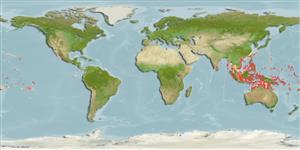Common names from other countries
Environment: milieu / climate zone / depth range / distribution range
Ecologia
marino associati a barriera corallina; distribuzione batimetrica 15 - 110 m (Ref. 27115). Tropical; 23°C - 28°C (Ref. 27115); 30°N - 18°S
Pacific Ocean: Indonesia to the Marquesas and Society Islands, north to Ryukyu Islands, south to Scott Reef. Range extends to Easter Island (Ref. 9710). Closely related to Anampses lineatus from the western Indian Ocean.
Size / Peso / Age
Maturity: Lm ? range ? - ? cm
Max length : 12.0 cm TL maschio/sesso non determinato; (Ref. 9710)
Spine dorsali (totale) : 9; Raggi dorsali molli (totale) : 12; Spine anali: 3; Raggi anali molli: 12. The primary phase of this species closely resembles that of A. meleagrides, but never has a uniformly yellow tail, and the color pattern does not change much with growth or sex (Ref. 1602). Recognized by the yellow bar on the base of the tail (Ref. 48636).
Adults occur in seaward reefs (Ref. 1602). Also in deep coastal to outer reef slopes and drop-offs (Ref. 48636). Solitary or in pairs in the surge zone, rarely to 30 m (Ref. 9710). They swim in small groups, each with several females and a single dominant male (Ref. 48636). Feed on small crustaceans, mollusks and polychaetes. Bury in sand at night (Ref. 9710). Oviparous, distinct pairing during breeding (Ref. 205). Maximum depth reported taken from Ref. 128797.
Life cycle and mating behavior
Maturities | Riproduzione | Spawnings | Egg(s) | Fecundities | Larve
Oviparous, distinct pairing during breeding (Ref. 205).
Myers, R.F., 1991. Micronesian reef fishes. Second Ed. Coral Graphics, Barrigada, Guam. 298 p. (Ref. 1602)
IUCN Red List Status (Ref. 130435)
CITES (Ref. 128078)
Not Evaluated
Threat to humans
Harmless
Human uses
Can't connect to MySQL database (fbapp). Errorcode: Too many connections
